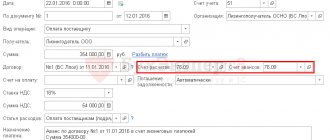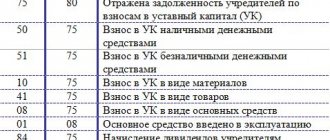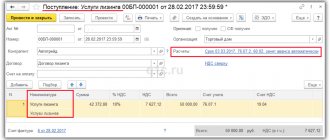How to get property
Simplified companies and individual entrepreneurs usually do not have sufficient working capital to immediately acquire ownership of the necessary property. Then organizations that provide property for leasing can help with this.
Subclause 4 of clause 1 of Article 346.16 of the Tax Code of the Russian Federation directly allows for the reduction of the single tax at the expense of leasing expenses under the simplified tax system. Namely, for the corresponding payments under the agreement for the acceptance of property on a leasing basis. They do this on the date that was later:
- day of transfer of payment;
- the last day of the month for which the payment is due.
VAT on leasing payments and redemption value is taken into account in costs along with the payments to which it relates.
Leasing, rent and loan: what is the difference
Equipment rental is also a solution to the problem. But there are disadvantages: you won't be able to charge depreciation on the rental property, and you won't own the equipment itself.
Another way out is lending. But loan terms are often prohibitive for small businesses.
Leasing is a hybrid of lending and renting. It is given on more favorable terms than a loan. As with rent, you will pay for the use of the property, but these payments will help you gradually buy the property. You will also accrue depreciation as you use it if the asset is on your balance sheet.
Accounting
Let’s look at what basic entries need to be made for leasing under the simplified tax system “income minus expenses.”
| OS received on lease: postings | ||
| № | Situation | How to proceed |
| 1 | Under the leasing agreement, the operating system does not immediately become the property of the simplifier | It must be reflected in off-balance sheet account 001 “Leased fixed assets” at the cost according to the agreement. The posting is as follows: Dt 001 – AMOUNT – the leased item is accepted for accounting. |
| 2 | The OS becomes the property of the simplifier | General OS rules apply |
The leasing payments themselves may appear in accounting:
- In expenses for ordinary activities (when the property is involved in the main production).
- In other costs (when the property is not involved in the main production).
| Leasing payments: postings | |
| Wiring | Content |
| Dt 20 (91) subaccount “Other expenses” – Kt 60 (76) subaccount “Settlements for the use of the leased asset” | Calculation of lease payment |
| Dt 60 (76) subaccount “Payments for the use of the leased asset” – Kt 51 | The lease payment is transferred (posting is done on the date of payment) |
For advances on lease payments, the entries will be as follows:
| Wiring | Content |
| Dt 60 (76) subaccount “Settlements for advances issued” – Kt 51 | Transfer of leasing payment in advance |
| Dt 20 (23, 25, 29, 44, 91 subaccount “Other expenses”) - Kt 60 (76) subaccount “Payments for the use of the leased asset” | Calculation of leasing payment (done monthly) |
| Dt 60 (76) subaccount “Settlements for the use of the leased asset” – K. 60 (76) subaccount “Settlements for advances issued” | Offsetting part of the advance or the entire advance against the debt to the lessor |
Features of leasing under the simplified tax system
If the leased property is listed on the lessee’s balance sheet, it will increase the total cost of fixed assets, which may affect the company’s ability to apply the simplified taxation system.
Article navigation
- Leasing payments under the simplified tax system
- Accounting for payments from the lessor
- Accounting for payments from the lessee
- Car leasing under simplified tax system: postings
- Transaction participants
- Required documents
- Pros and cons of leasing for legal entities
- Leasing transactions under the simplified tax system “Income minus expenses”
- Accounting for leasing on the lessor's balance sheet using the simplified tax system
- Accounting for leasing on the balance sheet of the lessee using the simplified tax system
- Results
Leasing is a universal financial instrument that is of interest to both small businesses and large companies. Today we will talk about the specifics of accounting for leasing operations at enterprises that use a simplified form of taxation.
The specificity of leasing, from the point of view of tax accounting, is that the assets that are the object of the agreement can be taken into account either on the balance sheet of the lessee or on the balance sheet of the owner. This condition is agreed upon by the parties when concluding the contract. The method of tax accounting depends on whose balance sheet the property is listed on.
There is a difference when accounting for leasing for companies operating under the simplified taxation system (STS) and the general taxation system (OSNO). In this material, we focus specifically on the first category of taxpayers who are interested in how to take leasing into account under the simplified tax system.
Receiving a car
Let us explain the tax accounting of one of the most popular transactions in this area – car leasing under the simplified tax system “income minus expenses”.
The redemption price is the simplified cost of purchasing the OS. You can include it as expenses only in the year when the car finally becomes the property of the simplified tax system. And during the year, such costs are written off in equal parts according to reporting periods. At the same time, they begin to do this from the one in which the car was purchased.
As for lease payments directly, they are taken into account when they were transferred.
An advance payment of the total leasing price cannot be immediately reflected in accounting. It is included in expenses gradually according to the number of months as it goes towards periodic payments.
Next, let’s look at an example of leasing under the simplified tax system “income minus expenses”.
EXAMPLE
Guru LLC applies the simplified tax system with the object “income minus expenses”. In September 2021, the company received a car under a leasing agreement. The contract period is 3 years. The total amount of payments under the agreement is 5,500,000 rubles. The company transfers an advance to the lessor in the amount of 1,750,000 rubles. Of this, 55,000 rubles go towards the redemption price. The rest of the advance is counted towards monthly payments.
Guru LLC makes monthly payments from October 2021 to September 2021 in the amount of 151,250 rubles. Of them:
- 104,167 rubles – transferred in cash;
- 47,083 rubles - counted towards advance payment.
When calculating the single tax on the simplified tax system, the company recognizes as expenses:
- monthly from October 2021 to September 2021 - leasing payment in the amount of 151,250 rubles;
- as of September 30, 2019 - part of the redemption price in the amount of RUB 27,500. (RUB 55,000 / 2);
- as of November 30, 2019 - part of the redemption price in the amount of RUB 27,500.
This example demonstrates very well how to take into account leasing costs under the simplified tax system. There are practically no special rules. After all:
- leasing fee is an analogue of rental payments;
- redemption price – the cost of purchasing a fixed asset.
Otherwise, accountants know that advances cannot be expensed until they are offset against goods supplied or services rendered. Therefore, leasing on the simplified tax system “income minus expenses”, if there are advances, is posted in the Book of Income and Expenses according to the number of months the contract is valid.
Also see “Manipulations with loans under the simplified tax system “income minus expenses”.
Read also
17.04.2017
How to reflect leasing payments in the lessor's accounting using the simplified tax system
The lessor reflects leasing payments as operating or non-operating income. The reflection must be done as soon as the funds are received in the company’s current account (Article 346.17 of the Tax Code of the Russian Federation).
Leasing does not always bring profit to the company. Sometimes it leads to losses. If such a situation occurs in a company, then according to clause 6 of Art. 346.18 of the Tax Code of the Russian Federation, she must still pay the minimum amount of the simplified tax.
If the leasing object is reflected on the balance sheet of the enterprise that leases it, then it can be attributed to the costs of purchasing fixed assets, except in cases of repurchase of the object, since then the property is taken into account after its sale (clause 23, clause 1, article 346.16 of the Tax Code of the Russian Federation) .
A company using the simplified tax system, when leasing fixed assets, must comply with 2 important conditions:
- her income for 9 months should not be more than 112.5 million rubles. (Clause 2 of Article 346.12 of the Tax Code of the Russian Federation);
- those listed on the balance sheet of fixed assets should not have a residual value of more than 150 million rubles. (Clause 16, Clause 3, Article 346.12 of the Tax Code of the Russian Federation).
The lessor company can fully take into account all the costs of the leased asset when:
- she sells it at the redemption price;
- the property was returned and she sells it to another company;
- the property was returned, and she herself began to use it as OS.
Advance payment
The organization will be able to offset it only after the service has been provided, that is, such an advance payment in practice is simply included in the payment schedule. Its payment is reflected on the bank statement, but will be included in expenses only when the lessee is issued documents confirming the expense - most often this is an invoice. To record the payment in KUDiR, you must enter a document - a manual entry of KUDiR (the postings will be similar to a regular lease payment - more on that later).
Acceptance of fixed assets for accounting
- Execute the document “Receipt of goods and services” by selecting the operation type Equipment. In this case, the amount of leasing payments for the entire term and the redemption price together are indicated, i.e. the full cost specified under the contract (usually in the payment schedule in the total line). Specify account 76.05 Settlements with other suppliers and contractors (the same for advances and for settlements). Thus, the document should create transactions: Dt 08.04 Kt 76.05.
- Draw up the document “Acceptance for accounting of fixed assets”. When filling out the tabular part of the “Fixed Assets” tab, create a new element in the “Fixed Assets” directory. On the “Accounting” tab, select “Depreciation” and fill in all the parameters. The useful life in this case is usually indicated by the period of validity of the leasing agreement (for example, if the contract is concluded for two years, then the useful life for the used lease is 24 months). Those. simplifiers must charge depreciation in accounting. And in tax accounting, under no circumstances, for organizations using the simplified tax system, there is no concept of depreciation.
However, there are some nuances when filling out the “Tax Accounting” tab: Firstly, the cost of fixed assets for tax accounting is indicated only by the redemption price specified in the leasing agreement.
Since leasing payments will be included in the expenses of the current period, the cost of the fixed asset can be taken into account in the KUDiR only at the moment when ownership of the fixed asset is transferred. On the NU tab in the document, the full useful life is indicated (for example, 36 months). In order for the cost of fixed assets to be included in KUDiR according to the rules (during the tax period by quarter as a percentage), the “Include in depreciation expenses” flag should be checked.
In addition, if an organization deals with a vehicle and is obliged to pay tax on the vehicle and provide a declaration to the lessee, then an entry should be made in the register of information “Vehicle Registration” about the fact of registering the car (to automatically fill out the declaration and calculate the tax).
advocatus54.ru
When registering it, as well as in the future when an insured event occurs, expenses, as for any other item, must be recorded in tax and accounting documents.
Attention Contents of the article ○ Accounting for expenses for compulsory motor liability insurance and comprehensive insurance.
It seems somewhat strange that the MTPL agreement does not cover the theft of a vehicle, however, for the purposes of insurance against such situations, there is CASCO. If it is concluded with a specific connection to theft, then the insured amount in this case cannot exceed the cost of the car. ✔ Tax accounting.
This does not provide any special features compared to the previous two types of insurance compensation: the amount received is considered non-operating income.
Portal about financial activities Through the posting “Debit 76.
Leasing under “simplified terms”: how to correctly draw up an agreement and take into account expenses (Kulukina N.A.)
And with leasing, you can not only use the property for a long time, but also buy it back at a relatively inexpensive price.
Lessors also benefit from the transactions. After all, such relationships allow them to receive income for a long period of time from funds invested in leased property. And everything would be fine if you do not forget about the tax accounting of leasing under the simplified tax system, which has many features. And if the income is more or less clear: the lessee usually does not generate it, and the lessor reflects all amounts received on the day of receipt, then taking into account expenses many questions arise.
We recommend reading: How to transfer a mortgage with maternity capital to one of the spouses
Let's talk about those that inevitably face organizations that have entered into a leasing agreement without the right of redemption or with one. If you have a “simplified” approach to the “income” object.







